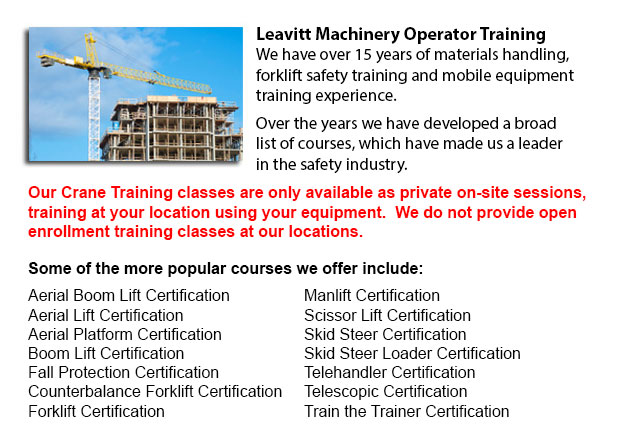
Crane Certification Prince Albert - The Crane Certification Program covers the industry recommended subject matter that will teach the safe and efficient operation of cranes. The individual will train in the following: how to identify cranes and their component parts; pre-operational, operational and post-operating requirements; rigging components and inspection/rejection criteria; how to determine overall lift capacity; and needs particular to the work location where the trainees would be operating.
The requirements which have to be done prior to operating a crane includes assigning authority for the pre-operational check; performing the sequential pre-operational check based on the manufacturer's specifications or specifications certified by a professional engineer; inspecting the work area for obstacles and hazards; checking the log book for comments; inspecting hooks, chains, cables, safety latches and crane movement; making sure of the proper functioning of operational controls; and knowing how to make sure that the disconnect switch/isolator of the crane is functioning correctly.
Operational requirements comprise identifying responsibilities and roles, and determining the need for a formal lift plan. Trainees will be taught how to perform a danger assessment related to environmental circumstances, physical conditions and staff. Subject matter comprises determining when to seek competent aid, the destination of loads and the safest route, and load weight and centre of gravity.
People training should be able to identify an over-capacity lift, in addition to be able to choose correct rigging machinery, select load limitations, and to determine the safe site for the crane to operate from. Trainees would review both site-specific and universal crane signals for lifts, and techniques for lifting, loading and traveling. Proper maintenance practice would be included.
The individuals training will undergo an examination to test their knowledge of emergency response procedures for various scenarios, particularly electrical or mechanical failures. They would be asked to describe parking and shut down procedures for security and safety, to follow lock out and tagging procedures, and to explain why near misses are reported and recorded to the right person. Log book records need to be maintained.
People training will develop knowledge of rigging, in particular, establishing who has authority and responsibility for rigging, identifying various types of rigging, knowing load capacity ratings and storage procedures.
The requirements following operation of the crane will be taught also, learning to enter the deficiencies and defects; and to log the history of service and maintenance records, in accordance to the federal, state and provincial codes requirements.
Site-specific needs could be included into the safety training program according to the employer's requirements.
-
Zoom Boom Training Prince Albert
Zoom Boom Training Prince Albert - Zoom Boom Training focuses on correctly training potential operators on variable reach forklifts. The training objectives include gaining the understanding of the machine's physics and to be able to define the job o... More -
Bucket Truck Training Prince Albert
Bucket Truck Training Prince Albert - The Vehicle-Mounted Aerial Work Platform or also called bucket truck training program is intended to reduce the chance of incident and personal injury when working with or in close proximity to bucket trucks by e... More -
Aerial Lift Training Prince Albert
Aerial Lift Training Prince Albert - An aerial work platform is a mechanized access platform. This device provides access to otherwise not accessible places for people or equipment. Likewise called an aerial device or elevating work platform, the mac... More -
Overhead Crane Ticket Prince Albert
Overhead Crane Ticket Prince Albert - The overhead crane is a common heavy machinery utilized in industrial settings. This particular machine is known as a bridge crane and comprises parallel runways spanned by a traveling bridge. The hoist is the co... More -
Scissor Lift Ticket Prince Albert
Scissor Lift Ticket Prince Albert - Scissor lifts have greatly benefited construction operations because the task that used to need a lot of effort and lots of people, can now be accomplished using the scissor lift and just one individual, the operat... More -
Manlift Training Prince Albert
Manlift Training Prince Albert - Different manlift training programs include the review and content of manlift devices. An essential part of the program is the practicum where students demonstrate their knowledge and practical ability to operate the... More -
Skid Steer Loader Training in Prince Albert
The engine powered skid-steer loader consists of a rigid and small frame, equipped along with lift arms which could attach to various industrial attachments and tools to be able to perform various labor saving tasks. Normally, skid-steer loaders are... More -
Crane Training School Prince Albert
Crane Training School Prince Albert - We provide industry relevant programs in our crane training school. The course will provide our trainees with learning outcomes matching the existing industry demands. Our small class sizes combine theory and han... More

Forklift Training Prince Albert
TOLL FREE: 1-888-254-6157
Prince Albert, Saskatchewan
forklifttrainingprincealbert.com
Email Us
About Us


